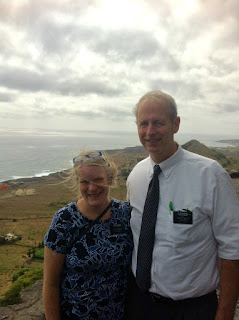Fire Island
Last week we flew to Fogo (Fire Island) to pursue and review humanitarian projects in the area. The flight was 25 minutes and very comfortable. There is also a boat, which takes four hours. Fogo has an active volcano, which rises 9,000 feet above sea level. the volcano last erupted in 2014 destroying villages and causing the relocation of many families. It's a small island and the volcano is big, so on Fogo when you travel you are either going up or going down, there are few flat areas. It's all just the sides of the volcano.


We spent most of our time with the wonderful Martineaus, a senior couple from Cedar City, Utah. We enjoyed our time with them. They graciously drove us around the island and to our humanitarian appointments. In addition to the Martineaus, the Church has 20 missionaries on Fogo.
Water Initiative
Our first appointment was with the water company Aguabrava. The Church subsidized improvements in water distribution on the island, including reservoirs and connections to homes high on the volcano. Fogo is the only one of Cabo Verde Islands that is water self-sufficient without relying on desalinization. Water gets trapped in the cone of the volcano, it percolates through the earth to the natural water table. It takes about 13 months for rain at the volcano to find its way to Sao Filipe, the main city on Fogo. The water is accessed through wells at a depth of about 450 feet. It is wonderful water. Getting it pumped to the upper locations is quite a feat, yet we stood in homes very high on the island and they had fantastic water pressure. As the Aguabrava executive explained to us, it was a very difficult project and the outcome is very good, it has taken five years to complete the the first of two projects.On Thursday, we toured the project sites with a representative of Aguabrava. Following are photos taken during the tour.
 There are very few beaches on Fogo and the ones there are are made of black sand.
There are very few beaches on Fogo and the ones there are are made of black sand.Subsistence agriculture is the major activity besides fishing.
The town of Mosteiros.
One of the many water reservoirs and pumping stations built as part of the project. The Mellennium Challenge Corporation provided major funding for improvements to the main water network, including additional water wells and network extensions. The Church partnered with local municipalities and Aguabrava to provide subsidized "last mile" connections to schools and to the houses of those to poor to be able to afford it otherwise.
Looking down on the community of Pai Antonio. One of the communities where the church played a significant role.
A local school that now has running water because of the Church's involvement.
One form of water distribution before the improvements. Many of the homes were 2,000 to 3,000 feet above sea level. Each day residents would have to make the trip to the nearest water station, fill containers and inner tubes with water and make the trip home. For those at the highest elevations this could take anywhere from 2 to 3 hours per day.
For those without donkeys, there was another way to get water home.
Standing near the center of Feijal looking down. Feijal was another community where many people were helped by the Church.
Same place as previous picture but looking up the mountain.
Pedro's house in the town of Feijal.
Pedro's new water spigot. Pedro spoke a few words of English. Not unusual on Fogo as many people have relatives that live in the United States. As early as the 1740's US whaling ships began recruiting crews from the islands of Brava and Fogo. Cabo Verdeans have fought in the US Military in all our major wars including the Revolutionary War. Today there are large Cabo Verdean communities in Boston and Brocton Massachusetts.
Pedro'a neighbor Jose showing off his water spigot. Water literally gushes out of these spigots. The water pressure is much better than in our apartment in Praia.
A town built in a lava field.
Most roads on Fogo are cobblestone. This man is a one person road repair crew.
A view of Mosteiros from about halfway up to the village of Feijal.
Other Activities
In addition to reviewing the water project, we met with other NGOs to discuss various possible projects. We were also able to meet many of the missionaries that Sister Biven has spoken to by phone.There is and Italian ex-patriot living in Sao Filipe who runs an Italian Pizzeria and Ice Cream shop; so later in the day we had ice cream and Italian food with the Martineaus. Because of the connection with the United States, the stores had more American products than we have seen since coming to Cabo Verde. There were all kinds of temptations. The treasure that we finally decided on purchasing was American deodorant, at somewhat exorbitant prices. Many Cabo Verdians that live in the US send back funds to support other family members, many visit the island on a regular basis bringing American items to their families in Fogo.
We were relaxed and happy after two days in the Fogo countryside and ready to return to our work in Praia, the largest city in Cape Verde. It was nice to get away, and good to come back.
















No comments:
Post a Comment